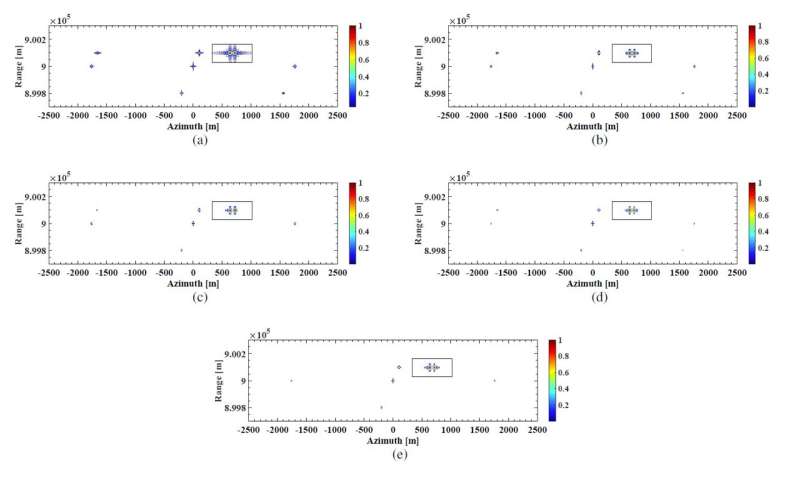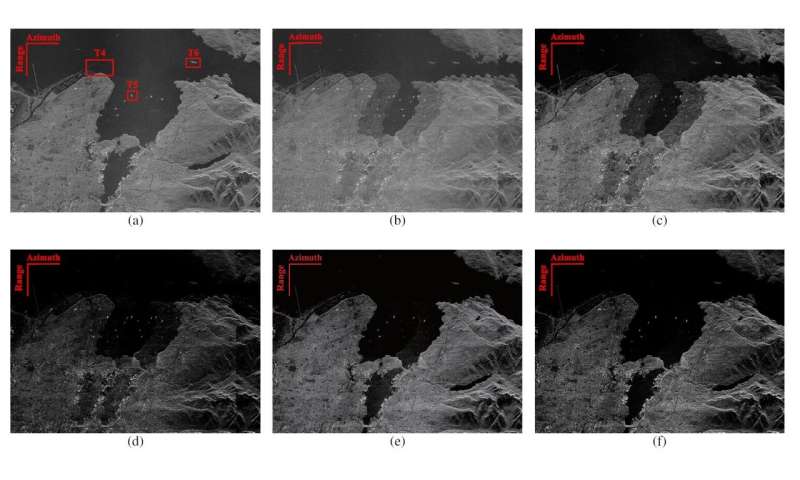Compared with traditional matched filtering (MF) based methods, sparse synthetic aperture radar (SAR) imaging could obtain high-quality images of sparse surveillance regions from down-sampled echo data. However, sparse SAR imaging still faces several challenges, especially in the fast recovery of large-scale scene and azimuth ambiguity suppression.
The received echo is discrete and finite in the time domain and shows infinite discreteness in the range-Doppler domain, which is equivalent to the periodic extension of the frequency spectrum of the main frequency band signal. The azimuth ambiguity is not serious when the pulse repetition frequency (PRF) satisfies the Shannon-Nyquist sampling theory. However, the sparse SAR system always aims to obtain a wide swath by reducing PRF, which will cause azimuth ambiguity, and even lead to failed reconstruction.
To solve the above problems, in a paper published in the journal Science China Information Sciences, with the help of approximated observation theory, researchers first solve the Lq-norm (0 2,1/2-norm regularization-based sparse SAR imaging method is proposed and applied to the unambiguous recovery of a large-scale sparse scene.
Since azimuth ambiguity terms are considered in model construction, the proposed method shows better performance than MF- and Lq-norm regularization-based methods in azimuth ambiguity suppression. While compared with the existing L2,1-norm regularization-based imaging method, it extends the capability of azimuth ambiguity suppression and can obtain the sparse image with higher quality.
-

Recovered images from 50% down-sampled data by (a) CSA, (b) L1-Sp, (c) L1/2-Sp, (d) L2,1-Sp, and (e) L2,1/2-Sp. Credit: Science China Press
-

Recovered images of large-scale scenes by (a) CSA from fully sampled data, (b) CSA from 50% down-sampled data,(c)L1-Sp from 50% down-sampled data,(d) L1/2-Sp from 50% down-sampled data, (e) L2,1-Sp from 50% down-sampled data, and (f) L2,1/2-Sp from 50% down-sampled data. Credit: Science China Press
The main contributions are as follows.
- Azimuth ambiguity terms are considered in model construction to extend the capability of azimuth ambiguity suppression.
- L2,1/2-norm regularization-based sparse SAR imaging method is proposed and applied to the unambiguous recovery of large-scale sparse scenes.
The proposed method has been validated on simulated and real data. In the point target simulation, researchers set four point targets from bottom to top and left to right, with two targets spaced at a smaller distance of 10m in the azimuth direction. They perform 50% uniform down-sampling for the fully sampled echo data by reducing PRF to verify the ability of methods to suppress azimuth ambiguity. In the real data experiment, the proposed method has been further validated based on the real Radarsat data.
More information:
Hui Bi et al, A novel sparse SAR unambiguous imaging method based on mixed-norm optimization, Science China Information Sciences (2023). DOI: 10.1007/s11432-022-3814-8
Citation:
A novel sparse synthetic aperture radar unambiguous imaging method based on mixed-norm optimization (2023, October 27)
retrieved 27 October 2023
from https://phys.org/news/2023-10-sparse-synthetic-aperture-radar-unambiguous.html
This document is subject to copyright. Apart from any fair dealing for the purpose of private study or research, no
part may be reproduced without the written permission. The content is provided for information purposes only.
Denial of responsibility! Samachar Central is an automatic aggregator of Global media. In each content, the hyperlink to the primary source is specified. All trademarks belong to their rightful owners, and all materials to their authors. For any complaint, please reach us at – [email protected]. We will take necessary action within 24 hours.

Shambhu Kumar is a science communicator, making complex scientific topics accessible to all. His articles explore breakthroughs in various scientific disciplines, from space exploration to cutting-edge research.


